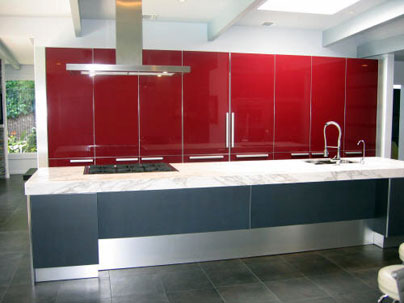Solid Aluminum Edgebanding?
Information about aluminum edgebanding. March 26, 2010
Question
Applying 1/16" thick solid aluminum with an edgebander- is this possible? Has anyone done it before? I've used solid aluminum as edgebanding before - but we applied it with contact cement. We sprayed it on and used a case clamp to press it down. It worked great, but labor intense. I'm going to try it this time with the edgebander, but could use some tips if anyone has experience applying solid aluminum with an edgebander. Here is a picture of my last job using aluminum edgebanding. By the way, that red paint was hand polished to a mirror finish. That's another topic, entirely!

Click here for higher quality, full size image
Forum Responses
(Cabinetmaking Forum)
From contributor M:
Nice kitchen. I've used "T" molding for this type face - also time consuming.
From contributor Z:
I know that Richter in MD sells metal edgebanding as I have a chain of samples on my desk somewhere. I never used it although I donít see why it would not work if you disable the guillotine on your edgbander.
From the original questioner:
I've used T molding on another job. It was very good but a bit too heavy looking for my eye. It was also a lot of work, but not as much as the strips with contact cement!
From contributor D:
If you can live with the "look" of solid aluminum edgebanding, Canplast and Dokken both have lines of banding that are clear acrylic with various metals printed on the backside. I used it this summer.
From the original questioner:
I know the stuff. Clear PVC overlaying a metal foil below? Good idea, but thats not quite the look I need.
From contributor S:
I've had the same issues, and went with the t-molding also, and as stated earlier, it was very time consuming. I started looking for edgebanders that are made for this purpose, and there are several out there. IDM makes one specifically for aluminum.
From the original questioner:
Where there other machines you were looking at and what sort of price ranges were you getting?
From contributor P:
The application of aluminum edging is not a hard process it's just expensive. Many years ago I ran solid brass edging at a trade show for a customer with no problem. According to the thickness of the edging you will need a machine with a guillotine heavy enough to cut the edging loose from the roll.
The thing to know is that the trim motors on most every commercial edgebander operate at 20,000 + RPM's. When trimming non-ferrus metals at this RPM you may see the cutters begin to gald or the material weld itself to the carbide on the cutter. To overcome this problem you need aluminum that is a harder material. There are several styles of Aluminum and the softer stuff is gummy when trimmed while the harder stuff cuts clean. The cutter RPM may need to be reduced. This is easy on most machines by changing the setting on the frequency drive to reduce the motor RPM.
Lastly you will need edging material that is clean and free from any oily residue that could have occurred during the MFG of it. Hotmelt does not adhere to an oily surface so worst case you may need to wipe it with lacquer thinner.
